Essay on Social Media's Influence on Marketing and Consumer Behavior
VerifiedAdded on 2023/05/28
|7
|2224
|123
Essay
AI Summary
This essay explores the significant impact of social media platforms, including Facebook, Instagram, and Snapchat, on consumer behavior and marketing strategies. It examines how the widespread adoption of these platforms has created new opportunities for marketers while simultaneously reshaping the way consumers make purchasing decisions. The essay delves into the ways social media facilitates personalized marketing, provides valuable consumer feedback, and influences the formation and spread of trends. Furthermore, it highlights how social media enables businesses, particularly small and medium-sized enterprises (SMEs), to reach broader audiences, engage with customers directly, and adapt their marketing campaigns quickly. The essay also discusses the challenges and benefits of social media marketing, including its role in shaping brand perceptions and managing word-of-mouth marketing. Ultimately, the essay concludes that social media marketing is essential for modern businesses, as it offers a comprehensive approach to research, customer engagement, and promotional effectiveness.
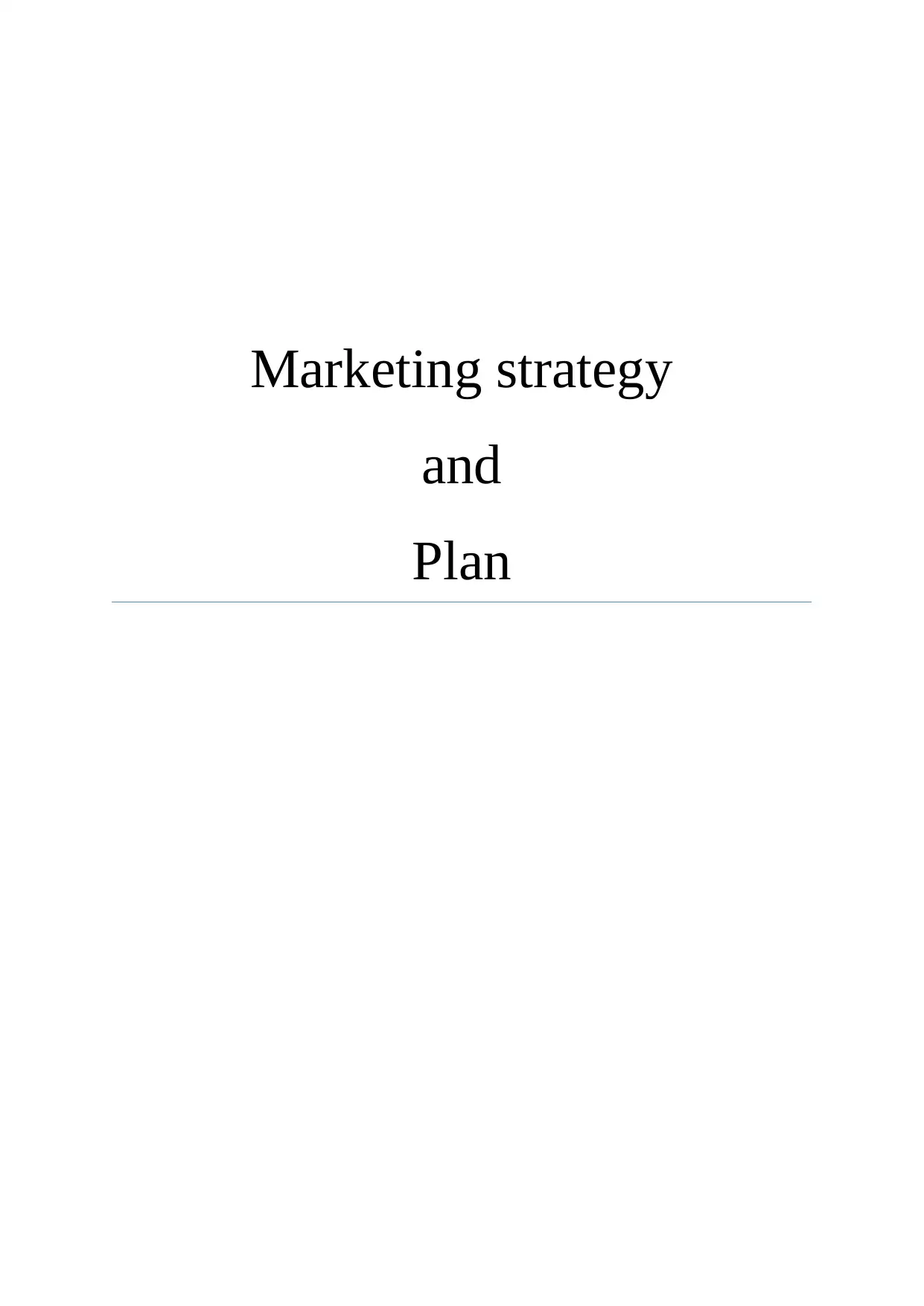
Marketing strategy
and
Plan
and
Plan
Paraphrase This Document
Need a fresh take? Get an instant paraphrase of this document with our AI Paraphraser
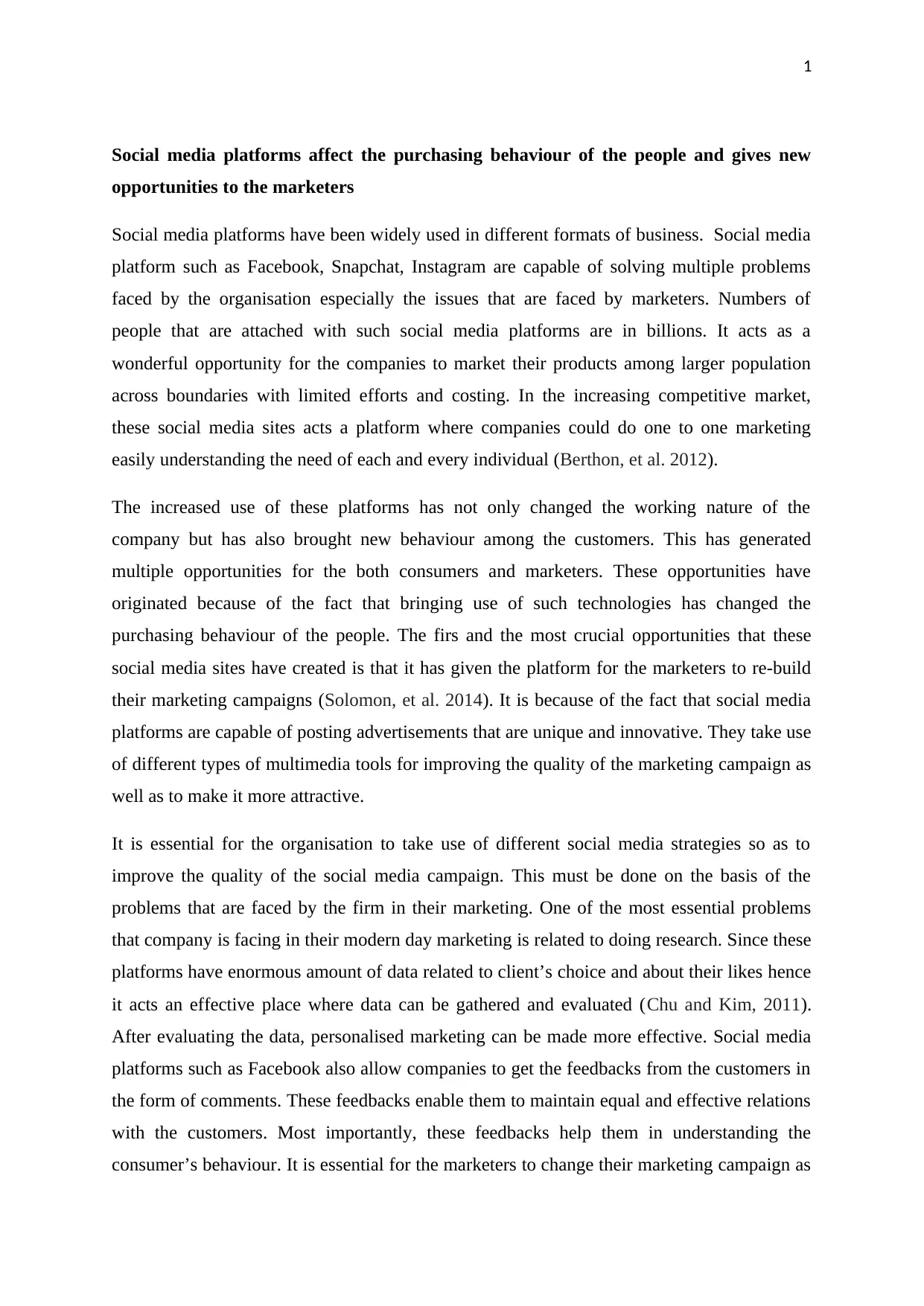
1
Social media platforms affect the purchasing behaviour of the people and gives new
opportunities to the marketers
Social media platforms have been widely used in different formats of business. Social media
platform such as Facebook, Snapchat, Instagram are capable of solving multiple problems
faced by the organisation especially the issues that are faced by marketers. Numbers of
people that are attached with such social media platforms are in billions. It acts as a
wonderful opportunity for the companies to market their products among larger population
across boundaries with limited efforts and costing. In the increasing competitive market,
these social media sites acts a platform where companies could do one to one marketing
easily understanding the need of each and every individual (Berthon, et al. 2012).
The increased use of these platforms has not only changed the working nature of the
company but has also brought new behaviour among the customers. This has generated
multiple opportunities for the both consumers and marketers. These opportunities have
originated because of the fact that bringing use of such technologies has changed the
purchasing behaviour of the people. The firs and the most crucial opportunities that these
social media sites have created is that it has given the platform for the marketers to re-build
their marketing campaigns (Solomon, et al. 2014). It is because of the fact that social media
platforms are capable of posting advertisements that are unique and innovative. They take use
of different types of multimedia tools for improving the quality of the marketing campaign as
well as to make it more attractive.
It is essential for the organisation to take use of different social media strategies so as to
improve the quality of the social media campaign. This must be done on the basis of the
problems that are faced by the firm in their marketing. One of the most essential problems
that company is facing in their modern day marketing is related to doing research. Since these
platforms have enormous amount of data related to client’s choice and about their likes hence
it acts an effective place where data can be gathered and evaluated (Chu and Kim, 2011).
After evaluating the data, personalised marketing can be made more effective. Social media
platforms such as Facebook also allow companies to get the feedbacks from the customers in
the form of comments. These feedbacks enable them to maintain equal and effective relations
with the customers. Most importantly, these feedbacks help them in understanding the
consumer’s behaviour. It is essential for the marketers to change their marketing campaign as
Social media platforms affect the purchasing behaviour of the people and gives new
opportunities to the marketers
Social media platforms have been widely used in different formats of business. Social media
platform such as Facebook, Snapchat, Instagram are capable of solving multiple problems
faced by the organisation especially the issues that are faced by marketers. Numbers of
people that are attached with such social media platforms are in billions. It acts as a
wonderful opportunity for the companies to market their products among larger population
across boundaries with limited efforts and costing. In the increasing competitive market,
these social media sites acts a platform where companies could do one to one marketing
easily understanding the need of each and every individual (Berthon, et al. 2012).
The increased use of these platforms has not only changed the working nature of the
company but has also brought new behaviour among the customers. This has generated
multiple opportunities for the both consumers and marketers. These opportunities have
originated because of the fact that bringing use of such technologies has changed the
purchasing behaviour of the people. The firs and the most crucial opportunities that these
social media sites have created is that it has given the platform for the marketers to re-build
their marketing campaigns (Solomon, et al. 2014). It is because of the fact that social media
platforms are capable of posting advertisements that are unique and innovative. They take use
of different types of multimedia tools for improving the quality of the marketing campaign as
well as to make it more attractive.
It is essential for the organisation to take use of different social media strategies so as to
improve the quality of the social media campaign. This must be done on the basis of the
problems that are faced by the firm in their marketing. One of the most essential problems
that company is facing in their modern day marketing is related to doing research. Since these
platforms have enormous amount of data related to client’s choice and about their likes hence
it acts an effective place where data can be gathered and evaluated (Chu and Kim, 2011).
After evaluating the data, personalised marketing can be made more effective. Social media
platforms such as Facebook also allow companies to get the feedbacks from the customers in
the form of comments. These feedbacks enable them to maintain equal and effective relations
with the customers. Most importantly, these feedbacks help them in understanding the
consumer’s behaviour. It is essential for the marketers to change their marketing campaign as
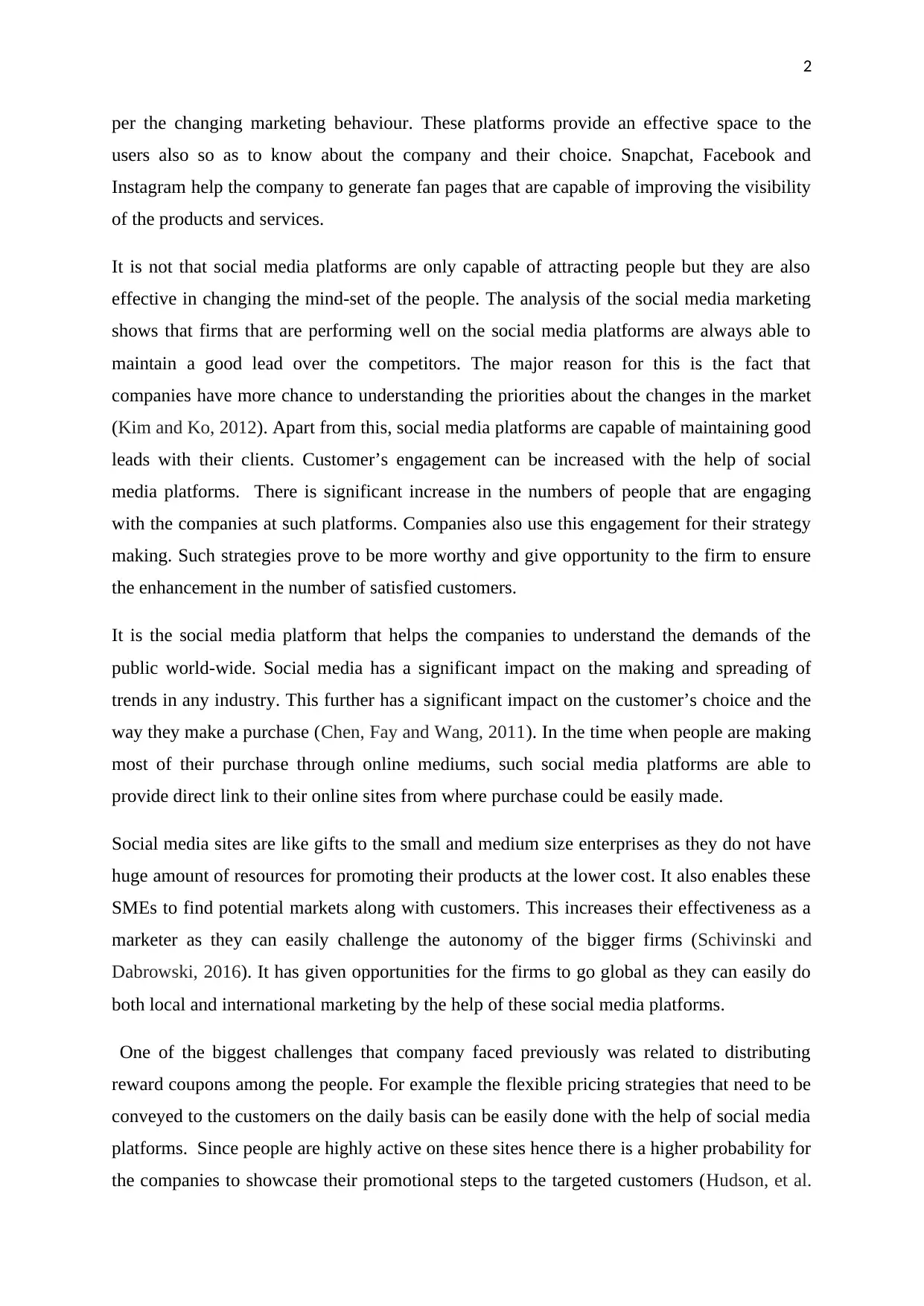
2
per the changing marketing behaviour. These platforms provide an effective space to the
users also so as to know about the company and their choice. Snapchat, Facebook and
Instagram help the company to generate fan pages that are capable of improving the visibility
of the products and services.
It is not that social media platforms are only capable of attracting people but they are also
effective in changing the mind-set of the people. The analysis of the social media marketing
shows that firms that are performing well on the social media platforms are always able to
maintain a good lead over the competitors. The major reason for this is the fact that
companies have more chance to understanding the priorities about the changes in the market
(Kim and Ko, 2012). Apart from this, social media platforms are capable of maintaining good
leads with their clients. Customer’s engagement can be increased with the help of social
media platforms. There is significant increase in the numbers of people that are engaging
with the companies at such platforms. Companies also use this engagement for their strategy
making. Such strategies prove to be more worthy and give opportunity to the firm to ensure
the enhancement in the number of satisfied customers.
It is the social media platform that helps the companies to understand the demands of the
public world-wide. Social media has a significant impact on the making and spreading of
trends in any industry. This further has a significant impact on the customer’s choice and the
way they make a purchase (Chen, Fay and Wang, 2011). In the time when people are making
most of their purchase through online mediums, such social media platforms are able to
provide direct link to their online sites from where purchase could be easily made.
Social media sites are like gifts to the small and medium size enterprises as they do not have
huge amount of resources for promoting their products at the lower cost. It also enables these
SMEs to find potential markets along with customers. This increases their effectiveness as a
marketer as they can easily challenge the autonomy of the bigger firms (Schivinski and
Dabrowski, 2016). It has given opportunities for the firms to go global as they can easily do
both local and international marketing by the help of these social media platforms.
One of the biggest challenges that company faced previously was related to distributing
reward coupons among the people. For example the flexible pricing strategies that need to be
conveyed to the customers on the daily basis can be easily done with the help of social media
platforms. Since people are highly active on these sites hence there is a higher probability for
the companies to showcase their promotional steps to the targeted customers (Hudson, et al.
per the changing marketing behaviour. These platforms provide an effective space to the
users also so as to know about the company and their choice. Snapchat, Facebook and
Instagram help the company to generate fan pages that are capable of improving the visibility
of the products and services.
It is not that social media platforms are only capable of attracting people but they are also
effective in changing the mind-set of the people. The analysis of the social media marketing
shows that firms that are performing well on the social media platforms are always able to
maintain a good lead over the competitors. The major reason for this is the fact that
companies have more chance to understanding the priorities about the changes in the market
(Kim and Ko, 2012). Apart from this, social media platforms are capable of maintaining good
leads with their clients. Customer’s engagement can be increased with the help of social
media platforms. There is significant increase in the numbers of people that are engaging
with the companies at such platforms. Companies also use this engagement for their strategy
making. Such strategies prove to be more worthy and give opportunity to the firm to ensure
the enhancement in the number of satisfied customers.
It is the social media platform that helps the companies to understand the demands of the
public world-wide. Social media has a significant impact on the making and spreading of
trends in any industry. This further has a significant impact on the customer’s choice and the
way they make a purchase (Chen, Fay and Wang, 2011). In the time when people are making
most of their purchase through online mediums, such social media platforms are able to
provide direct link to their online sites from where purchase could be easily made.
Social media sites are like gifts to the small and medium size enterprises as they do not have
huge amount of resources for promoting their products at the lower cost. It also enables these
SMEs to find potential markets along with customers. This increases their effectiveness as a
marketer as they can easily challenge the autonomy of the bigger firms (Schivinski and
Dabrowski, 2016). It has given opportunities for the firms to go global as they can easily do
both local and international marketing by the help of these social media platforms.
One of the biggest challenges that company faced previously was related to distributing
reward coupons among the people. For example the flexible pricing strategies that need to be
conveyed to the customers on the daily basis can be easily done with the help of social media
platforms. Since people are highly active on these sites hence there is a higher probability for
the companies to showcase their promotional steps to the targeted customers (Hudson, et al.
⊘ This is a preview!⊘
Do you want full access?
Subscribe today to unlock all pages.

Trusted by 1+ million students worldwide
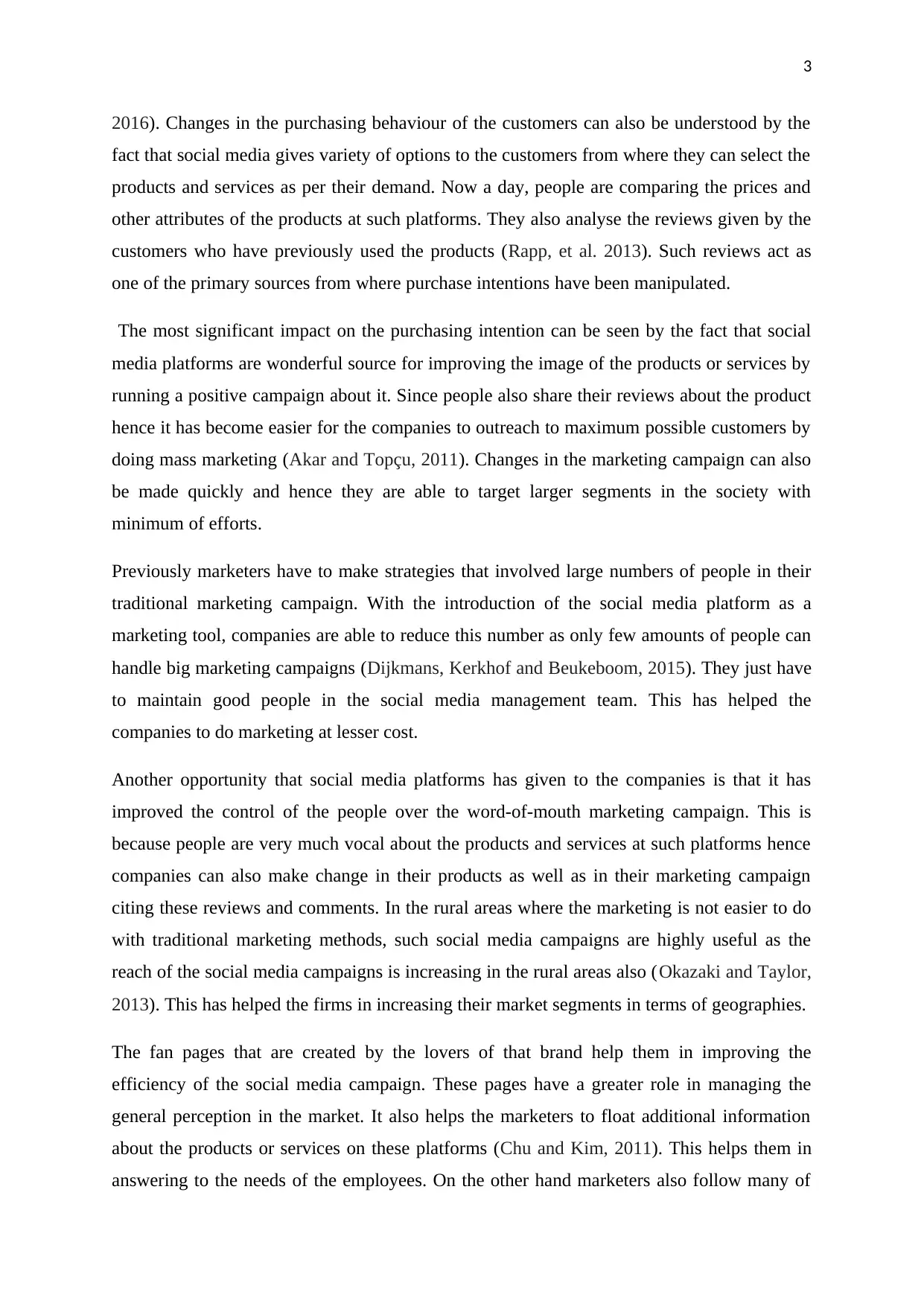
3
2016). Changes in the purchasing behaviour of the customers can also be understood by the
fact that social media gives variety of options to the customers from where they can select the
products and services as per their demand. Now a day, people are comparing the prices and
other attributes of the products at such platforms. They also analyse the reviews given by the
customers who have previously used the products (Rapp, et al. 2013). Such reviews act as
one of the primary sources from where purchase intentions have been manipulated.
The most significant impact on the purchasing intention can be seen by the fact that social
media platforms are wonderful source for improving the image of the products or services by
running a positive campaign about it. Since people also share their reviews about the product
hence it has become easier for the companies to outreach to maximum possible customers by
doing mass marketing (Akar and Topçu, 2011). Changes in the marketing campaign can also
be made quickly and hence they are able to target larger segments in the society with
minimum of efforts.
Previously marketers have to make strategies that involved large numbers of people in their
traditional marketing campaign. With the introduction of the social media platform as a
marketing tool, companies are able to reduce this number as only few amounts of people can
handle big marketing campaigns (Dijkmans, Kerkhof and Beukeboom, 2015). They just have
to maintain good people in the social media management team. This has helped the
companies to do marketing at lesser cost.
Another opportunity that social media platforms has given to the companies is that it has
improved the control of the people over the word-of-mouth marketing campaign. This is
because people are very much vocal about the products and services at such platforms hence
companies can also make change in their products as well as in their marketing campaign
citing these reviews and comments. In the rural areas where the marketing is not easier to do
with traditional marketing methods, such social media campaigns are highly useful as the
reach of the social media campaigns is increasing in the rural areas also (Okazaki and Taylor,
2013). This has helped the firms in increasing their market segments in terms of geographies.
The fan pages that are created by the lovers of that brand help them in improving the
efficiency of the social media campaign. These pages have a greater role in managing the
general perception in the market. It also helps the marketers to float additional information
about the products or services on these platforms (Chu and Kim, 2011). This helps them in
answering to the needs of the employees. On the other hand marketers also follow many of
2016). Changes in the purchasing behaviour of the customers can also be understood by the
fact that social media gives variety of options to the customers from where they can select the
products and services as per their demand. Now a day, people are comparing the prices and
other attributes of the products at such platforms. They also analyse the reviews given by the
customers who have previously used the products (Rapp, et al. 2013). Such reviews act as
one of the primary sources from where purchase intentions have been manipulated.
The most significant impact on the purchasing intention can be seen by the fact that social
media platforms are wonderful source for improving the image of the products or services by
running a positive campaign about it. Since people also share their reviews about the product
hence it has become easier for the companies to outreach to maximum possible customers by
doing mass marketing (Akar and Topçu, 2011). Changes in the marketing campaign can also
be made quickly and hence they are able to target larger segments in the society with
minimum of efforts.
Previously marketers have to make strategies that involved large numbers of people in their
traditional marketing campaign. With the introduction of the social media platform as a
marketing tool, companies are able to reduce this number as only few amounts of people can
handle big marketing campaigns (Dijkmans, Kerkhof and Beukeboom, 2015). They just have
to maintain good people in the social media management team. This has helped the
companies to do marketing at lesser cost.
Another opportunity that social media platforms has given to the companies is that it has
improved the control of the people over the word-of-mouth marketing campaign. This is
because people are very much vocal about the products and services at such platforms hence
companies can also make change in their products as well as in their marketing campaign
citing these reviews and comments. In the rural areas where the marketing is not easier to do
with traditional marketing methods, such social media campaigns are highly useful as the
reach of the social media campaigns is increasing in the rural areas also (Okazaki and Taylor,
2013). This has helped the firms in increasing their market segments in terms of geographies.
The fan pages that are created by the lovers of that brand help them in improving the
efficiency of the social media campaign. These pages have a greater role in managing the
general perception in the market. It also helps the marketers to float additional information
about the products or services on these platforms (Chu and Kim, 2011). This helps them in
answering to the needs of the employees. On the other hand marketers also follow many of
Paraphrase This Document
Need a fresh take? Get an instant paraphrase of this document with our AI Paraphraser
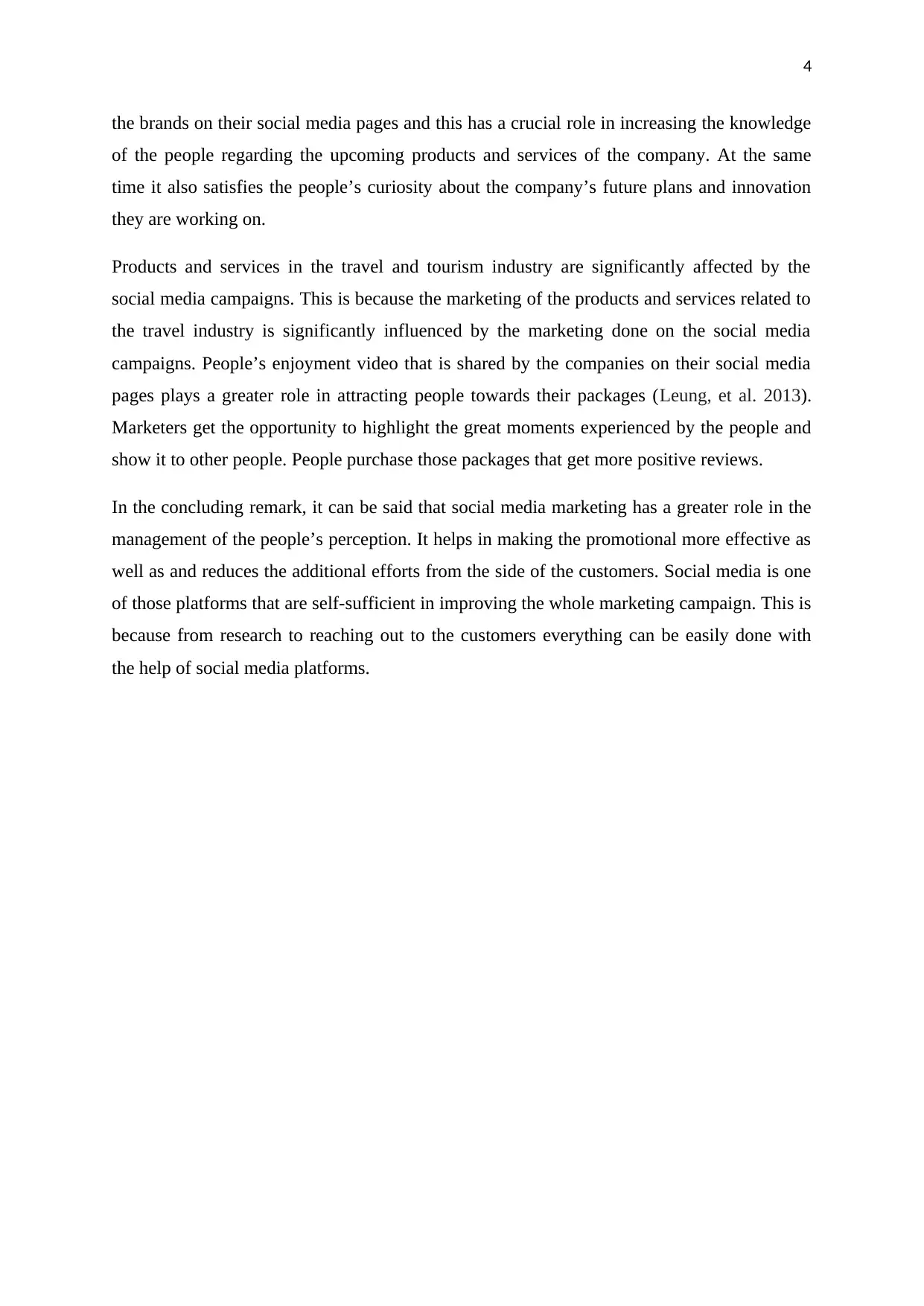
4
the brands on their social media pages and this has a crucial role in increasing the knowledge
of the people regarding the upcoming products and services of the company. At the same
time it also satisfies the people’s curiosity about the company’s future plans and innovation
they are working on.
Products and services in the travel and tourism industry are significantly affected by the
social media campaigns. This is because the marketing of the products and services related to
the travel industry is significantly influenced by the marketing done on the social media
campaigns. People’s enjoyment video that is shared by the companies on their social media
pages plays a greater role in attracting people towards their packages (Leung, et al. 2013).
Marketers get the opportunity to highlight the great moments experienced by the people and
show it to other people. People purchase those packages that get more positive reviews.
In the concluding remark, it can be said that social media marketing has a greater role in the
management of the people’s perception. It helps in making the promotional more effective as
well as and reduces the additional efforts from the side of the customers. Social media is one
of those platforms that are self-sufficient in improving the whole marketing campaign. This is
because from research to reaching out to the customers everything can be easily done with
the help of social media platforms.
the brands on their social media pages and this has a crucial role in increasing the knowledge
of the people regarding the upcoming products and services of the company. At the same
time it also satisfies the people’s curiosity about the company’s future plans and innovation
they are working on.
Products and services in the travel and tourism industry are significantly affected by the
social media campaigns. This is because the marketing of the products and services related to
the travel industry is significantly influenced by the marketing done on the social media
campaigns. People’s enjoyment video that is shared by the companies on their social media
pages plays a greater role in attracting people towards their packages (Leung, et al. 2013).
Marketers get the opportunity to highlight the great moments experienced by the people and
show it to other people. People purchase those packages that get more positive reviews.
In the concluding remark, it can be said that social media marketing has a greater role in the
management of the people’s perception. It helps in making the promotional more effective as
well as and reduces the additional efforts from the side of the customers. Social media is one
of those platforms that are self-sufficient in improving the whole marketing campaign. This is
because from research to reaching out to the customers everything can be easily done with
the help of social media platforms.
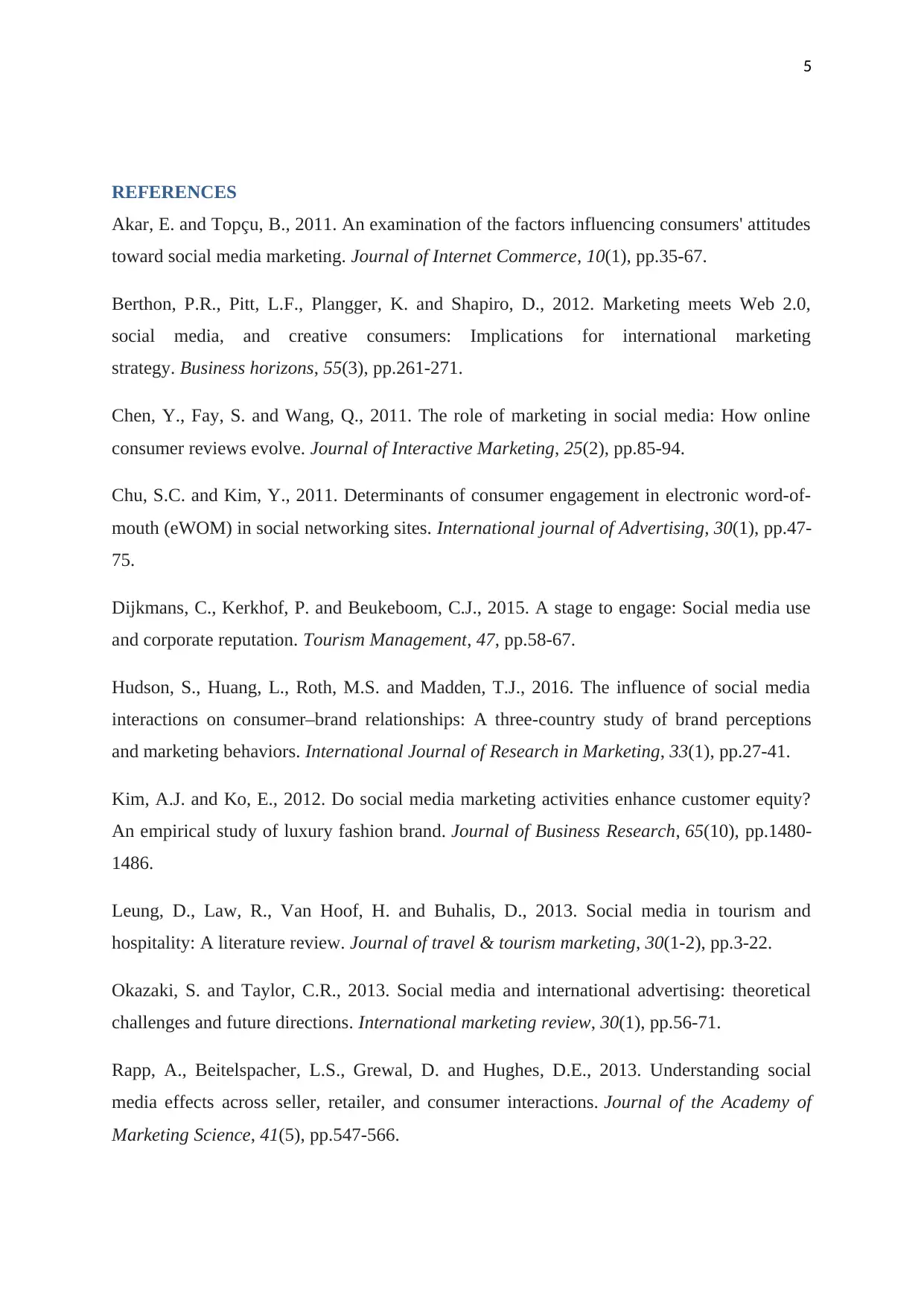
5
REFERENCES
Akar, E. and Topçu, B., 2011. An examination of the factors influencing consumers' attitudes
toward social media marketing. Journal of Internet Commerce, 10(1), pp.35-67.
Berthon, P.R., Pitt, L.F., Plangger, K. and Shapiro, D., 2012. Marketing meets Web 2.0,
social media, and creative consumers: Implications for international marketing
strategy. Business horizons, 55(3), pp.261-271.
Chen, Y., Fay, S. and Wang, Q., 2011. The role of marketing in social media: How online
consumer reviews evolve. Journal of Interactive Marketing, 25(2), pp.85-94.
Chu, S.C. and Kim, Y., 2011. Determinants of consumer engagement in electronic word-of-
mouth (eWOM) in social networking sites. International journal of Advertising, 30(1), pp.47-
75.
Dijkmans, C., Kerkhof, P. and Beukeboom, C.J., 2015. A stage to engage: Social media use
and corporate reputation. Tourism Management, 47, pp.58-67.
Hudson, S., Huang, L., Roth, M.S. and Madden, T.J., 2016. The influence of social media
interactions on consumer–brand relationships: A three-country study of brand perceptions
and marketing behaviors. International Journal of Research in Marketing, 33(1), pp.27-41.
Kim, A.J. and Ko, E., 2012. Do social media marketing activities enhance customer equity?
An empirical study of luxury fashion brand. Journal of Business Research, 65(10), pp.1480-
1486.
Leung, D., Law, R., Van Hoof, H. and Buhalis, D., 2013. Social media in tourism and
hospitality: A literature review. Journal of travel & tourism marketing, 30(1-2), pp.3-22.
Okazaki, S. and Taylor, C.R., 2013. Social media and international advertising: theoretical
challenges and future directions. International marketing review, 30(1), pp.56-71.
Rapp, A., Beitelspacher, L.S., Grewal, D. and Hughes, D.E., 2013. Understanding social
media effects across seller, retailer, and consumer interactions. Journal of the Academy of
Marketing Science, 41(5), pp.547-566.
REFERENCES
Akar, E. and Topçu, B., 2011. An examination of the factors influencing consumers' attitudes
toward social media marketing. Journal of Internet Commerce, 10(1), pp.35-67.
Berthon, P.R., Pitt, L.F., Plangger, K. and Shapiro, D., 2012. Marketing meets Web 2.0,
social media, and creative consumers: Implications for international marketing
strategy. Business horizons, 55(3), pp.261-271.
Chen, Y., Fay, S. and Wang, Q., 2011. The role of marketing in social media: How online
consumer reviews evolve. Journal of Interactive Marketing, 25(2), pp.85-94.
Chu, S.C. and Kim, Y., 2011. Determinants of consumer engagement in electronic word-of-
mouth (eWOM) in social networking sites. International journal of Advertising, 30(1), pp.47-
75.
Dijkmans, C., Kerkhof, P. and Beukeboom, C.J., 2015. A stage to engage: Social media use
and corporate reputation. Tourism Management, 47, pp.58-67.
Hudson, S., Huang, L., Roth, M.S. and Madden, T.J., 2016. The influence of social media
interactions on consumer–brand relationships: A three-country study of brand perceptions
and marketing behaviors. International Journal of Research in Marketing, 33(1), pp.27-41.
Kim, A.J. and Ko, E., 2012. Do social media marketing activities enhance customer equity?
An empirical study of luxury fashion brand. Journal of Business Research, 65(10), pp.1480-
1486.
Leung, D., Law, R., Van Hoof, H. and Buhalis, D., 2013. Social media in tourism and
hospitality: A literature review. Journal of travel & tourism marketing, 30(1-2), pp.3-22.
Okazaki, S. and Taylor, C.R., 2013. Social media and international advertising: theoretical
challenges and future directions. International marketing review, 30(1), pp.56-71.
Rapp, A., Beitelspacher, L.S., Grewal, D. and Hughes, D.E., 2013. Understanding social
media effects across seller, retailer, and consumer interactions. Journal of the Academy of
Marketing Science, 41(5), pp.547-566.
⊘ This is a preview!⊘
Do you want full access?
Subscribe today to unlock all pages.

Trusted by 1+ million students worldwide
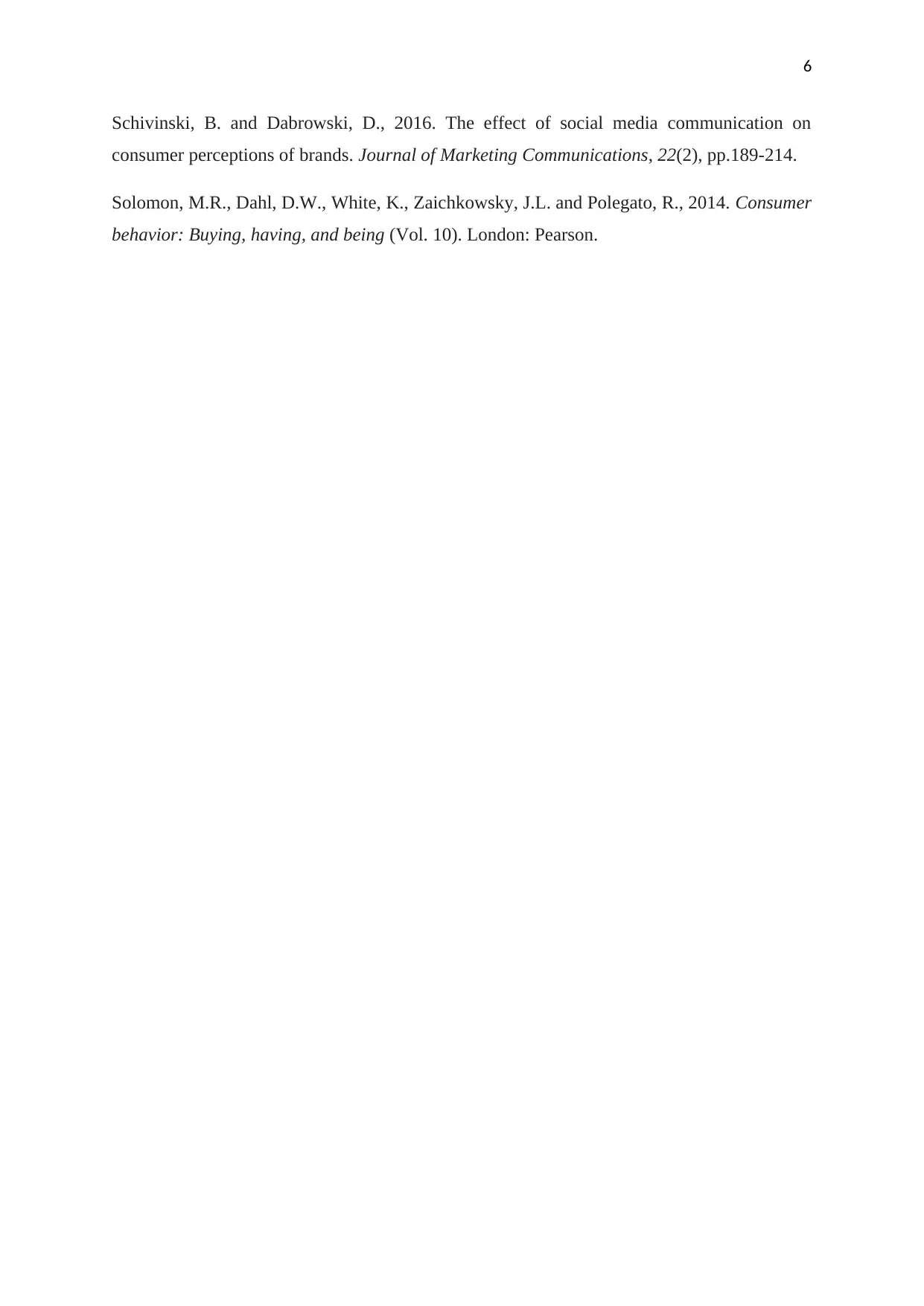
6
Schivinski, B. and Dabrowski, D., 2016. The effect of social media communication on
consumer perceptions of brands. Journal of Marketing Communications, 22(2), pp.189-214.
Solomon, M.R., Dahl, D.W., White, K., Zaichkowsky, J.L. and Polegato, R., 2014. Consumer
behavior: Buying, having, and being (Vol. 10). London: Pearson.
Schivinski, B. and Dabrowski, D., 2016. The effect of social media communication on
consumer perceptions of brands. Journal of Marketing Communications, 22(2), pp.189-214.
Solomon, M.R., Dahl, D.W., White, K., Zaichkowsky, J.L. and Polegato, R., 2014. Consumer
behavior: Buying, having, and being (Vol. 10). London: Pearson.
1 out of 7
Related Documents
Your All-in-One AI-Powered Toolkit for Academic Success.
+13062052269
info@desklib.com
Available 24*7 on WhatsApp / Email
![[object Object]](/_next/static/media/star-bottom.7253800d.svg)
Unlock your academic potential
Copyright © 2020–2025 A2Z Services. All Rights Reserved. Developed and managed by ZUCOL.




